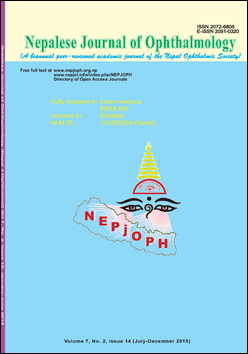Outcomes of implantable collamer lens V4 and V4c for correction of high myopia – a case series
DOI:
https://doi.org/10.3126/nepjoph.v7i2.14967Keywords:
ICL, Centra flowAbstract
Objective: To evaluate the visual outcomes and intraocular pressure changes after Visian Implantable Collamer Lens (ICL) implantation V4b and V4c (with centraflow technology) for correction of myopia.
Materials and methods: A prospective, consecutive, comparative interventional case series of V4b and V4c ICL implantation done for correction of high myopia (>-6 diopter D) in patients unsuitable for laser vision correction. The outcome measures that were evaluated included preoperative and postoperative uncorrected distant visual acuity (UDVA), best spectacle corrected distant visual acuity (CDVA), endothelial cell count (ECC), presence of lens opacification, intraocular pressure (IOP) and ICL vaulting. A follow-up of upto 1 year was done. A questionnaire was given at the end of follow-up period.
Results: A total of 30 eyes (24.56±4.8 years) underwent V4b ICL implantation (10 non-toric, 20 toric ICL-TICL) with intraoperative peripheral iridectomy (PI) and 34 eyes (26.13±3.8 years) had implantation of V4c ICL with centraflow (12 non-toric, 22 TICL). The mean preoperative manifest spherical equivalent (MSE) was 8.98±2.8 D and 9.24±2.4 D in the V4b and V4c groups respectively which reduced to postoperative values of -0.28±1.3 D and -0.19±1.18 D respectively. The mean preoperative astigmatism was -1.8±1.2 diopter cylinder (Dcyl) and -1.9±1.6 Dcyl which respectively reduced to -0.8±0.8 Dcyl and -0.9±0.3 Dcyl. At the end of 1 year follow up, mean ECC loss was 7.6% and 7.1%, mean vault was 583.12±231.12 μ and 602±241.24μ respectively in the V4b and V4c groups. Anterior subcapsular opacities were present in 6.66% and 2.94% of eyes with V4b and V4c groups respectively. Two eyes from both V4b (10%) and V4c (8.33%) had rotation of more than 30 degrees and required re-rotation surgery done successfully. Two eyes (6.66%) with V4b ICL implantation had high postoperative IOP (>35 mm Hg) and required Nd:Yag laser iridotomy later done with successful control of IOP. The safety indices were 1.12 and 1.15 and efficacy indices were 1.5 and 1.6 in the V4b and V4c groups respectively at the end of 1 year. The most common visual complaint was glare and haloes in 24% and 27% in the two groups respectively. However, they were not annoying enough to cause visual disability.
Conclusions: Both V4b and V4c Visian ICL implantations are comparable in terms of visual outcome and safety profile for correction of high myopia. However, V4c ICL offers these advantages without the requirement of an additional PI.
Downloads
Downloads
Published
How to Cite
Issue
Section
License
This license enables reusers to copy and distribute the material in any medium or format in unadapted form only, for noncommercial purposes only, and only so long as attribution is given to the creator.




